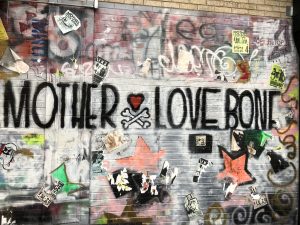The Seattle grunge scene of the 1990s was a revolutionary moment in music history. It brought a new sound and attitude to rock music, influencing countless bands and musicians in the years since.
However, behind the music and the hype, there were many ugly truths about the scene that are often overlooked. In this article, we will explore six of the most significant and often unspoken aspects of the Seattle grunge scene.
The Seattle grunge scene was more than just a musical genre. It was a cultural movement that shaped a generation, and its impact is still felt today. Despite the many challenges and struggles faced by those involved, the scene left a lasting legacy that continues to inspire and influence musicians and fans around the world.
1. Drug Abuse Was Rampant
Heroin was particularly prevalent. The Seattle grunge scene was marked by with many musicians struggling with addiction.
Heroin was not only a recreational drug for many musicians, but also a coping mechanism for dealing with the pressures of fame, the stresses of touring, and the often-debilitating effects of mental health issues such as depression and anxiety. For some, heroin provided a temporary escape from their problems, but it ultimately led to a downward spiral of addiction and despair.
The impact of drug abuse on the Seattle grunge scene was far-reaching. It affected not only the musicians themselves, but also their families, friends, and fans. The deaths of high-profile musicians such as Andy Wood, Kurt Cobain and Layne Staley, in particular, had a profound impact on the music world and marked the end of an era for the Seattle grunge scene.
Despite the tragedies that resulted from drug abuse, it was also a defining aspect of the Seattle grunge scene. The music was marked by a raw, unfiltered honesty that reflected the realities of addiction and mental illness. It was a reflection of the darker aspects of human nature that often go unspoken in polite society.
While drug abuse was undoubtedly a destructive force in the Seattle grunge scene, it was also an infamous part of its legacy.

2. Mental Health Issues Were Common
Many musicians were struggling with depression, anxiety, and other mental health issues, which often manifested in their music. The raw emotion and angst that characterized much of the music of the Seattle grunge scene were a reflection of the mental health struggles that many musicians were going through.
The pressures of fame, the grueling touring schedule, and the intense scrutiny of the music industry could exacerbate existing mental health issues or lead to the onset of new ones.
Musicians were often thrust into the public eye before they were emotionally prepared to handle the pressures that came with it. The Seattle grunge scene was also characterized by a culture of self-destructiveness and nihilism, which could be especially harmful to those struggling with mental health issues.
While mental health issues were a pervasive problem in the Seattle grunge scene, they were also an integral part of its legacy. The music was a reflection of the darker aspects of the human psyche, and many fans identified with the raw emotion and honesty of the music.
The willingness of musicians to address these issues head-on helped to destigmatize mental illness and encouraged others to seek help. Today, many musicians continue to speak openly about their struggles with mental health issues, in part due to the example set by those who came before them in the Seattle grunge scene.
Kurt Cobain, in particular, was vocal about his struggles with depression and addiction, and many of his songs addressed these issues directly. Cobain's suicide in 1994 was a stark reminder of the toll that mental health issues can take on even the most successful and talented individuals.

3. Record Labels Wanted to Exploit Musicians
The Seattle grunge scene was marked by a certain level of commercial success, but this success also came at a cost. As the popularity of the scene grew, it began to attract the attention of major record labels, and many of the bands were signed to lucrative recording contracts. While this helped to bring the music of the Seattle grunge scene to a wider audience, it also led to a certain level of commodification, and some felt that the music had lost its authenticity.
The commercial success of the Seattle grunge scene also brought with it a level of media attention that some felt was intrusive and invasive. The media often portrayed the musicians in the Seattle grunge scene as troubled and dysfunctional, focusing on their personal lives rather than their music. This attention could be overwhelming for some musicians, and contributed to a sense of disillusionment and burnout.
The commercialization of the Seattle grunge scene also led to a certain level of backlash from fans who felt that the music had become too mainstream and had lost its original spirit. Some fans felt that the music had become too polished and commercialized, and that the raw, gritty sound that had defined the scene had been lost.
Despite these challenges, the Seattle grunge scene continued to exert a significant influence on popular music. The success of the scene helped to bring alternative rock into the mainstream, and paved the way for other alternative rock bands to find success in the years that followed.
Today, the legacy of the Seattle grunge scene can still be seen in the many musicians who continue to draw inspiration from the music and the ethos of the scene.


4. Musicians Struggled Financially
The Seattle grunge scene was marked by a certain level of social and political consciousness. Many of the musicians in the scene were deeply engaged with issues of social justice and political activism, and used their music as a means of expressing their views and connecting with their audiences.
The music of the Seattle grunge scene often addressed issues such as economic inequality, environmental degradation, and social isolation. Many of the lyrics were highly personal and introspective, reflecting the experiences and concerns of the musicians themselves. This personal approach to songwriting helped to create a sense of intimacy between the musicians and their audiences and contributed to the emotional impact of the music.
The social and political consciousness of the Seattle grunge scene was also reflected in the scene's activism. Many of the musicians in the scene were involved in local activism, working to address issues such as homelessness and poverty. Some bands even organized benefit concerts and other events to raise awareness and funds for these causes.
The social and political consciousness of the Seattle grunge scene helped to create a sense of purpose and meaning for the musicians involved. It also helped to connect the music to larger social and political movements and contributed to the overall impact of the scene.
Today, the legacy of the Seattle grunge scene can still be seen in the many musicians and artists who continue to use their music as a means of expressing their views and engaging with social and political issues. The scene's focus on personal expression, social justice, and political activism continues to inspire new generations of musicians and fans.

5. The Legacy Is Complicated
The Seattle grunge scene was marked by a sense of tragedy and loss, as many of the key figures in the scene struggled with addiction, mental illness, and other personal demons. Some of the most iconic figures of the scene, such as Kurt Cobain of Nirvana and Layne Staley of Alice in Chains, tragically passed away at young ages as a result of their struggles.
The sense of tragedy and loss within the Seattle grunge scene was reflected in the music, which often dealt with themes of depression, isolation, and addiction. Many of the lyrics were deeply personal and raw, reflecting the experiences and struggles of the musicians themselves.
Despite the sense of tragedy and loss within the Seattle grunge scene, it also helped to create a sense of catharsis and healing for many of the musicians and fans involved. The music provided a space for people to connect with each other and express their emotions and helped to foster a sense of community and support.
Today, the legacy of the Seattle grunge scene can still be seen in the many musicians and fans who continue to connect with the music on a deeply personal level. The scene's focus on personal expression, emotional intensity, and sense of community has helped to create a lasting impact on rock music and popular culture as a whole.
The Seattle grunge scene was a time of great creativity, passion, and innovation, but it was also marked by many ugly truths. The issues faced by the scene were complex and multifaceted, and continue to have an impact on the music industry and society as a whole.
Despite these challenges, the Seattle grunge scene left a lasting legacy that continues to inspire and influence musicians and fans today. Its impact can be seen in the many bands and artists who continue to experiment with new sounds and ideas, and in the ongoing conversation around social and political issues in music.
The Seattle grunge scene may have been flawed, but it was also a powerful force for change and creativity. Its legacy lives on, reminding us of the importance of honest expression, experimentation, and community in music and culture.



